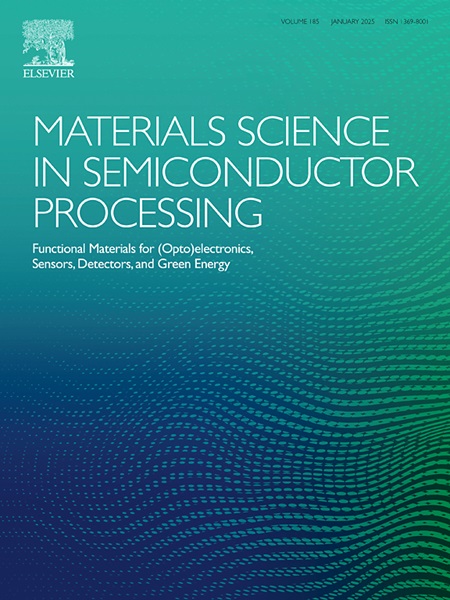Role of cerium dopant in tuning the semiconductor-to-metal transition properties of magnesium zinc ferrite nanomaterials
IF 4.6
3区 工程技术
Q2 ENGINEERING, ELECTRICAL & ELECTRONIC
引用次数: 0
Abstract
In this research work, Magnesium zinc ferrite (CexMgZn1-xFe2O4) nanomaterials have been synthesized with various cerium concentrations (x = 0, 0.05, 0.1, 0.15) using the coprecipitation method. With no deformation as per structural analysis, cerium ions are doped in the spinel lattice of MgZnFe2O4 nanomaterials. The undoped MgZnFe2O4 with initial flake-like morphology is changed to cube-like shapes upon Ce (x = 0.15) addition. The DC resistivity exhibits a varying pattern in both ferromagnetic and paramagnetic regions as temperature increases. Furthermore, the samples with x = 0.15 exhibit a high resistivity on the order of 1.09∗1010 Ω cm, and an activation energy of 0.909 eV. The dielectric properties, such as dielectric constant, dielectric losses, and impedance, exhibit a progressive drop as the frequency increases from 1 MHz to 2 MHz. Furthermore, dielectric parameters reach their lowest value in the dopant x = 0.1. The highest Q values for x = 0.05 and 0.15 indicate that the mentioned materials are most suitable for use in high-frequency devices, likewise multi-layer chip inductors and resonant circuits. Growth inhibition of two types of bacterial extracts (E.Coli and S. aureus) has been studied. Results revealed MgZnFe2O4 enhanced growth inhibition against S. aureus bacteria with increasing Ce concentration, however, inhibition of E. Coli is hampered (50 % at maximum) by Ce incorporation into ferrite lattice.

铈掺杂剂在调整镁锌铁氧体纳米材料的半导体到金属转变特性中的作用
在这项研究工作中,采用共沉淀法合成了不同铈浓度(x = 0、0.05、0.1、0.15)的镁锌铁氧体(CexMgZn1-xFe2O4)纳米材料。根据结构分析,铈离子在 MgZnFe2O4 纳米材料的尖晶石晶格中没有变形。添加铈(x = 0.15)后,未掺杂的 MgZnFe2O4 最初的片状形态变为立方体状。随着温度的升高,直流电阻率在铁磁区和顺磁区都呈现出不同的形态。此外,x = 0.15 的样品表现出 1.09∗1010 Ω cm 的高电阻率和 0.909 eV 的活化能。介电特性,如介电常数、介电损耗和阻抗,随着频率从 1 MHz 增加到 2 MHz 而逐渐下降。此外,介电参数在掺杂剂 x = 0.1 时达到最低值。x = 0.05 和 0.15 时的 Q 值最高,这表明上述材料最适合用于高频设备,如多层片式电感器和谐振电路。研究了两种细菌提取物(大肠杆菌和金黄色葡萄球菌)的生长抑制作用。研究结果表明,随着 Ce 浓度的增加,MgZnFe2O4 对金黄色葡萄球菌的生长抑制作用增强,但是,Ce 加入铁氧体晶格后,对大肠杆菌的抑制作用减弱(最大减弱 50%)。
本文章由计算机程序翻译,如有差异,请以英文原文为准。
求助全文
约1分钟内获得全文
求助全文
来源期刊

Materials Science in Semiconductor Processing
工程技术-材料科学:综合
CiteScore
8.00
自引率
4.90%
发文量
780
审稿时长
42 days
期刊介绍:
Materials Science in Semiconductor Processing provides a unique forum for the discussion of novel processing, applications and theoretical studies of functional materials and devices for (opto)electronics, sensors, detectors, biotechnology and green energy.
Each issue will aim to provide a snapshot of current insights, new achievements, breakthroughs and future trends in such diverse fields as microelectronics, energy conversion and storage, communications, biotechnology, (photo)catalysis, nano- and thin-film technology, hybrid and composite materials, chemical processing, vapor-phase deposition, device fabrication, and modelling, which are the backbone of advanced semiconductor processing and applications.
Coverage will include: advanced lithography for submicron devices; etching and related topics; ion implantation; damage evolution and related issues; plasma and thermal CVD; rapid thermal processing; advanced metallization and interconnect schemes; thin dielectric layers, oxidation; sol-gel processing; chemical bath and (electro)chemical deposition; compound semiconductor processing; new non-oxide materials and their applications; (macro)molecular and hybrid materials; molecular dynamics, ab-initio methods, Monte Carlo, etc.; new materials and processes for discrete and integrated circuits; magnetic materials and spintronics; heterostructures and quantum devices; engineering of the electrical and optical properties of semiconductors; crystal growth mechanisms; reliability, defect density, intrinsic impurities and defects.
 求助内容:
求助内容: 应助结果提醒方式:
应助结果提醒方式:


